Spherical chrysanthemums are in demand in landscape design; they are used to create borders of flower beds and complement various compositions, as well as to decorate paths. The plant can be called unpretentious, but this applies only to the warm seasons, as they have almost no immunity to low temperatures. As soon as the bushes begin to prepare for a dormant period, they require increased attention to themselves. Multiflora Chrysanthemum: wintering in open ground, how to cover, when to dig and how save the plant.
Content
How to prepare chrysanthemum for winter
Any plant, gaining strength, is actively fed by nutrients before moving to a dormant state, chrysanthemum is no exception. To help the flower withstand sub-zero temperatures, fertilizers begin to be applied already from the first days of September. In the summer-autumn period, potassium-phosphorus mixtures are ideally suited, they contribute not only to abundant flowering, but also to the strengthening of immunity.
The second, no less important event is pruning. The procedure is carried out as late as possible (when the first frosts grab the ground) so that the juice from all the stems goes to the root, thus avoiding the depletion of the plant. All dry, weakened or spoiled branches should be removed, as well as old shoots, there is a risk that in the future they will begin to rot. Rot will spread to the rest of the stems. The main shoots are shortened to 15 cm (miniature varieties up to 10 cm), young shoots can be left as is.
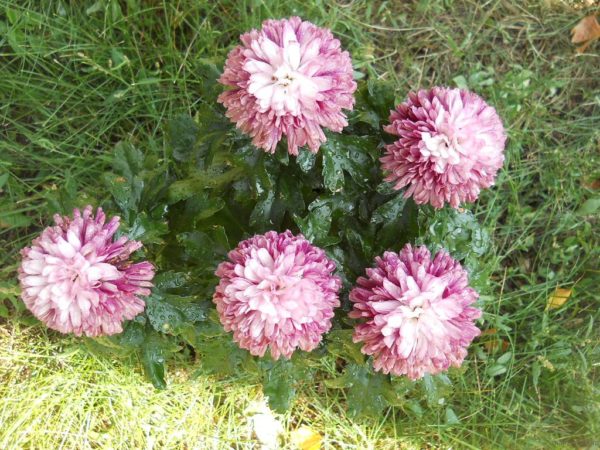
From the first days of summer until the onset of autumn cold weather, you need to closely monitor the bushes. When the slightest signs of disease or pests appear, they are immediately sprayed with suitable drugs, it is important not only to cure chrysanthemum at a certain stage, but also to prevent the recurrence of ailments (to carry out several more preventative treatments).
Features of wintering multiflora
Without shelter, the heat-loving chrysanthemum winters well only in the southern regions of Russia with short, snowy and moderately frosty winters. In the middle lane, and especially in the north, bushes are usually dug up and create optimal conditions for storage. Many gardeners got used to leaving the chrysanthemum in its place even in cold areas, then preparing for winter should include the organization of a reliable shelter.
Shelter of chrysanthemums for the winter
There are several ways to protect chrysanthemums in the open. The principle of their construction is very simple, but be careful, any improper action can lead to freezing of the bush. Even with a partial loss of stems and roots, the plant will recover for a long time, which will negatively affect flowering and decorativeness in general. How to arrange shelter:
- Bricks are installed on the sides of the bush, if there are several chrysanthemums, then the stones can be laid out in a row. On top of a kind of support, the board is laid so that it completely covers the structure. You can use slate or metal. A load is laid on top of the canvas so that a strong wind does not blow it. Water will not get to the chrysanthemums, while the bushes will be well ventilated from the sides.
- The bushes are covered with spruce branches or dry branches, covered with leaves from above (layer at least 15 cm). It is advisable to additionally cover the plant with polyethylene or spanbond.
- In warm regions, high hilling of bushes is carried out, it is important not to leave pits around the chrysanthemum, in which moisture can accumulate.
- Some gardeners recommend covering the flowers with wooden or plastic crates, leaving a little free space below for ventilation.
It is necessary to cover the bushes when the weather is moderately frosty, it is not necessary before, chrysanthemums can mate. Each time after snowfall, a snowdrift is thrown over covered plants. A significant drawback of the winter shelter of a flower is the inability to control its condition during wintering, the result will be visible only in the spring.
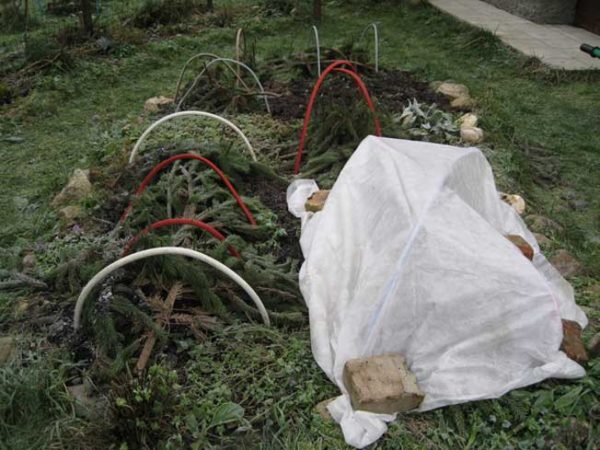
How to dig out chrysanthemums
You need to dig up the bushes so as not to damage the roots, otherwise there will be a risk of developing various diseases. During storage, the plant will spend a lot of energy on root restoration, after spring planting, even with good care chrysanthemum will grow very slowly. In a critical case, spoiling of the roots leads to the death of the bush. For everything to go well, take precautions:
- the soil around the bushes should be abundantly watered with water so that when the plant is removed the earth does not crumble;
- no need to shake the ground from the roots, it is advisable to keep the whole lump in its original form;
- to leave excess moisture from the soil, the bushes must be left for 1-2 days in the air.
Only a correctly dug out chrysanthemum will tolerate wintering, it does not matter which storage method you choose. It is necessary to transfer prepared bushes carefully, it is better to lay them in a row or one by one on plywood sheets, if this is not possible, hold the plant by the stem and by whom the earth is at the same time, so that the soil does not crumble. You can use buckets, then the bushes are folded and transferred one at a time.
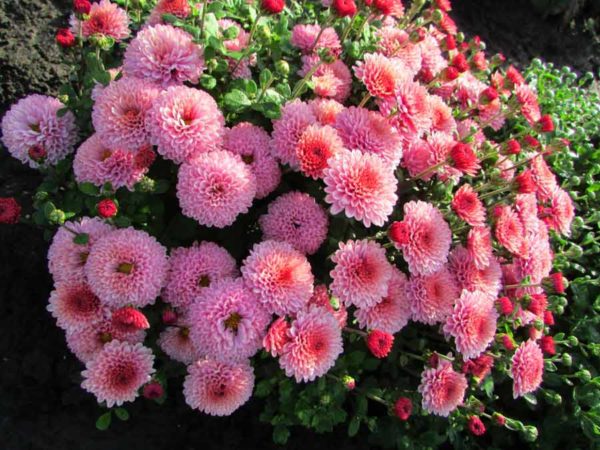
How and where to store chrysanthemum
In cold regions, dug bushes are transferred to the room, and in areas where the soil does not freeze too deep and much snow falls, the plant can be buried on the street. The decision on how to store flowers in the winter, each gardener must make their own. Understanding which option is better does not make sense, a lot depends not only on the climate of the region, but also on the possibility of placing chrysanthemums at home.
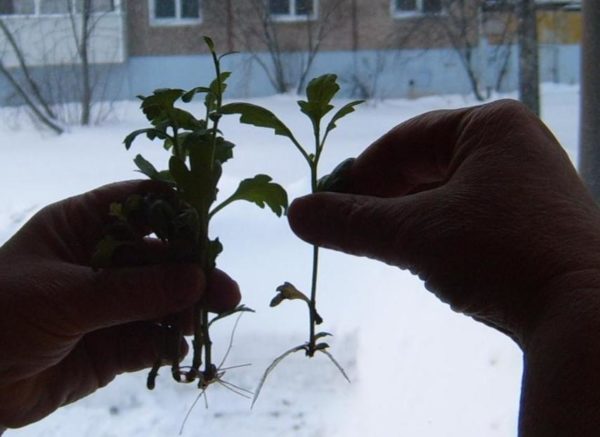 You may be interested in:
You may be interested in:Trench storage
A ditch is dug at a selected site, with a depth of 50 cm to a meter, the length depends on the number of bushes, the width of the trench should be no more than a bayonet shovel (20-30 cm). Chrysanthemums are laid at the bottom of the pit so that they are as tight as possible to each other, folding in 2 layers is allowed. All the free space in the trench should be covered with very loose soil, cover the entire surface with spruce branches and covered with leaves on top.
To protect the plant from the accumulation of water, boards are laid on the leaves, covered with roofing material and polyethylene. The edges of the film are fixed with pegs, stones or sprinkled with earth. On top of the film, it is advisable to throw a good hill of foliage, and when snow falls, make a high snowdrift in this place. In the spring, at the first thaws, the shelter is removed gradually, in layers, in this way it will be possible to protect the plant from a sharp temperature drop.
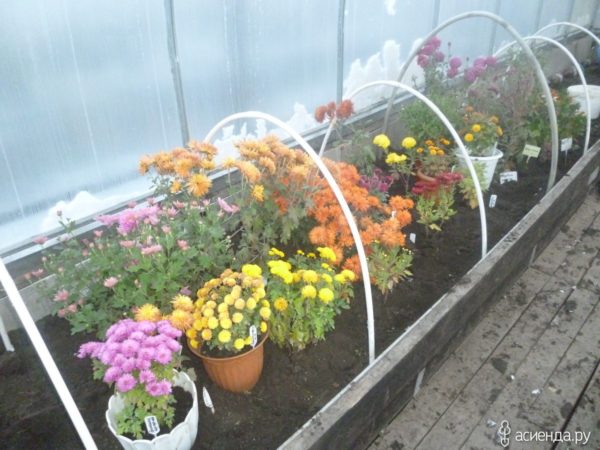
Potted storage
The roots of the chrysanthemum grow in breadth, so the container should also be wide, the depth is not important, the main thing is that after the transplantation of the bush the root is not exposed. Loose soil is prepared to fill the free space in the container, you can take garden soil and mix it with perlite 1: 1. To avoid waterlogging that is undesirable for a flower, drain holes are made at the bottom of the container and a drainage layer is laid (about 2 cm). Gravel, broken stone or expanded clay will do.
You can dig and transplant another flowering bush, for some time it will bloom on the windowsill or on the balcony. In this case, pruning is carried out 5 or 10 days after the buds wither. Store a faded, trimmed bush in a dark, cool room with moderate air humidity. If you leave the chrysanthemum in the light or warm, it will let out young growth, will not go into a dormant state, and by the spring the bush will greatly weaken. Plant the plant in its original place as soon as return frosts pass.
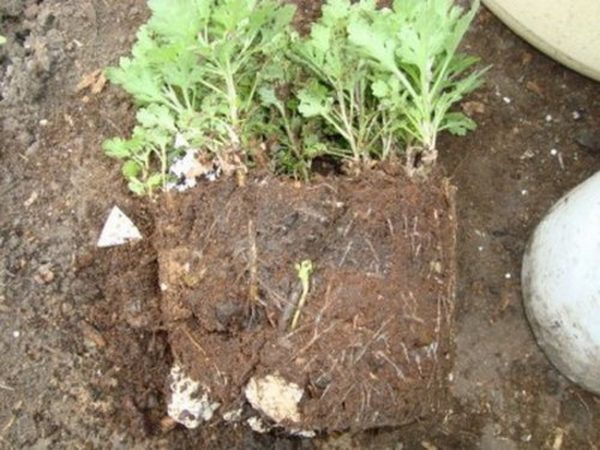 You may be interested in:
You may be interested in:Greenhouse storage
Still flowering chrysanthemums are transplanted into the greenhouse, holes are dug to the size of the root, no need to deepen the bushes. Pruning is carried out when the stems begin to freeze, under such conditions leaves branches no higher than 4 cm.The bushes are covered with a good layer of humus, and on top with dry soil, a layer of 20 to 25 cm.You can not even use slightly moist soil, the bushes quickly decay under such a pillow. A heat-resistant, waterproof material is covered with earth.
The method is quite risky, since in spring you need to try to seize the moment in order to open the bushes, otherwise they will quickly reproach under such shelter. It is necessary to dig up multiflora when a stable plus temperature is established in the greenhouse, after a couple of weeks the plants can be transplanted to their original place. In a heated greenhouse, where the temperature is always kept between 0-5 degrees, it is not necessary to cover the chrysanthemum.
Storage in a cellar or basement
The easiest and most affordable way, common among flower growers of the Moscow Region, under natural conditions, the heat-loving chrysanthemum does not winter here. Dug bushes are stacked in boxes or on the floor (in one row), tight to each other. A layer of earth is poured at least 5 cm to the bottom of the container or to the floor, and the roots are also sprinkled on top of the ground. It is important that the air in the basement or cellar is not dry, such conditions will not contribute to the normal preservation of the flower. The temperature in the room should not rise above 4 degrees or fall below 0.
In the basement you need to tidy up - remove fungus and mold, as well as insects and rodents. After moving the bushes to the storage place, you do not need to constantly care for them. Once a month you can inspect the stems, all ripened, rotted bushes are removed from the basement, the rest are treated with antiseptics. If some plants have dried out roots, they need to be sprayed a little with water. In the case when, due to a violation of the temperature regime, chrysanthemums begin to grow, the room is ventilated.
The experience of storing chrysanthemum multiflora in winter
Anastasia
The year before last I bought miniature spherical chrysanthemums, how to save them in the winter I did not know then and did not take care of the bushes. Cottage in the Moscow region, in the spring of 5 bushes only one survived, reached the middle of summer and dried up. Last year, I dug up only faded bushes, planted part in a greenhouse, covered it with humus and agrofiber, carried the other part to the basement. The flowers normally wintered, but they did not develop well, now I understand my mistake - you can’t dig out too early, I expected good frosts this fall.
Helena
I store multiflora in the trench, even in Siberia this method does not fail. I don’t fall asleep with leaves, I lay on the spruce branches a layer of various melons from the garden, and on top slate and film. Before digging, I water the bushes well, first I dig up the chrysanthemum on the sides, then gently take it out with a large lump of earth, immediately replant it, but cover it a little later, when the soil dries. When we lived in the south, I covered the bushes with a wooden box with gaps, sprinkled them with leaves a bit so that moisture would not get in, laid polyethylene, and in winter threw snow.
Winter storage of multiflora chrysanthemums is a simple task, but you need to treat it responsibly. Choose the best method for yourself and stick to our recommendations, then a thermophilic flower will delight you with abundant flowering annually. To understand which storage option is best for a particular region, try several at once, this will greatly increase the likelihood of success.

 Sow in the ground, without seedlings: 10 beautiful and unpretentious flowers
Sow in the ground, without seedlings: 10 beautiful and unpretentious flowers Platicodon planting and outdoor care
Platicodon planting and outdoor care Hosta - planting and care in the open ground in the Urals
Hosta - planting and care in the open ground in the Urals Oleander - care and growing at home
Oleander - care and growing at home